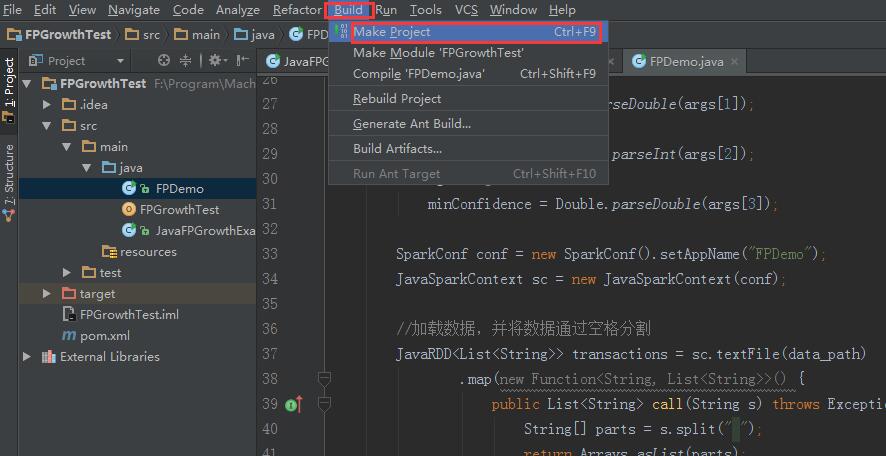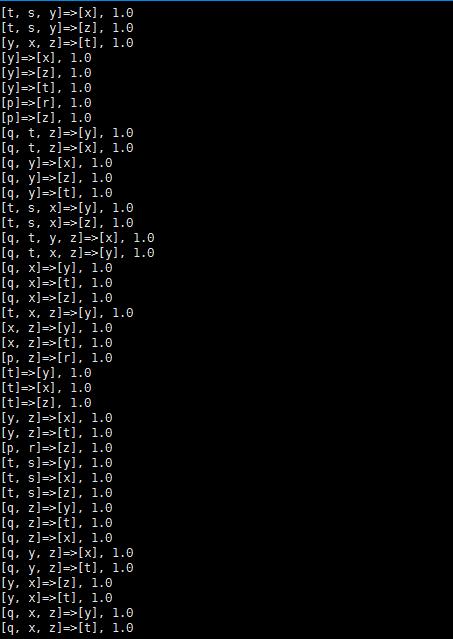一、FPGrowth算法理解
Spark.mllib 提供并行FP-growth算法,这个算法属于关联规则算法【关联规则:两不相交的非空集合A、B,如果A=>B,就说A=>B是一条关联规则,常提及的{啤酒}-->{尿布}就是一条关联规则】,经常用于挖掘频度物品集。关于算法的介绍网上很多,这里不再赘述。主要搞清楚几个概念:
1)支持度support(A => B) = P(AnB) = |A n B| / |N|,表示数据集D中,事件A和事件B共同出现的概率;
2)置信度confidence(A => B) = P(B|A) = |A n B| / |A|,表示数据集D中,出现事件A的事件中出现事件B的概率;
3)提升度lift(A => B) = P(B|A):P(B) = |A n B| / |A| : |B| / |N|,表示数据集D中,出现A的条件下出现事件B的概率和没有条件A出现B的概率;
由上可以看出,支持度表示这条规则的可能性大小,而置信度表示由事件A得到事件B的可信性大小。
举个列子:10000个消费者购买了商品,尿布1000个,啤酒2000个,同时购买了尿布和啤酒800个。
1)支持度:在所有项集中出现的可能性,项集同时含有,x与y的概率。尿布和啤酒的支持度为:800/10000=8%
2)置信度:在X发生的条件下,Y发生的概率。尿布-》啤酒的置信度为:800/1000=80%,啤酒-》尿布的置信度为:800/2000=40%
3)提升度:在含有x条件下同时含有Y的可能性(x->y的置信度)比没有x这个条件下含有Y的可能性之比:confidence(尿布=> 啤酒)/概率(啤酒)) = 80%/(2000/10000) 。如果提升度=1,那就是没啥关系这两个
通过支持度和置信度可以得出强关联关系,通过提升的,可判别有效的强关联关系。
直接拿例子来说明问题。首先数据集如下:
r z h k p
z y x w v u t s
s x o n r
x z y m t s q e
z
x z y r q t pimport org.apache.spark.SparkConf;
import org.apache.spark.api.java.JavaRDD;
import org.apache.spark.api.java.JavaSparkContext;
import org.apache.spark.api.java.function.Function;
import org.apache.spark.mllib.fpm.AssociationRules;
import org.apache.spark.mllib.fpm.FPGrowth;
import org.apache.spark.mllib.fpm.FPGrowthModel;
import java.util.Arrays;
import java.util.List;
public class FPDemo {
public static void main(String[] args){
String data_path; //数据集路径
double minSupport = 0.2;//最小支持度
int numPartition = 10; //数据分区
double minConfidence = 0.8;//最小置信度
if(args.length < 1){
System.out.println("<input data_path>");
System.exit(-1);
}
data_path = args[0];
if(args.length >= 2)
minSupport = Double.parseDouble(args[1]);
if(args.length >= 3)
numPartition = Integer.parseInt(args[2]);
if(args.length >= 4)
minConfidence = Double.parseDouble(args[3]);
SparkConf conf = new SparkConf().setAppName("FPDemo").setMaster("local");
JavaSparkContext sc = new JavaSparkContext(conf);
//加载数据,并将数据通过空格分割
JavaRDD<List<String>> transactions = sc.textFile(data_path)
.map(new Function<String, List<String>>() {
public List<String> call(String s) throws Exception {
String[] parts = s.split(" ");
return Arrays.asList(parts);
}
});
//创建FPGrowth的算法实例,同时设置好训练时的最小支持度和数据分区
FPGrowth fpGrowth = new FPGrowth().setMinSupport(minSupport).setNumPartitions(numPartition);
FPGrowthModel<String> model = fpGrowth.run(transactions);//执行算法
//查看所有频繁諅,并列出它出现的次数
for(FPGrowth.FreqItemset<String> itemset : model.freqItemsets().toJavaRDD().collect())
System.out.println("[" + itemset.javaItems() + "]," + itemset.freq());
//通过置信度筛选出强规则
//antecedent表示前项
//consequent表示后项
//confidence表示规则的置信度
for(AssociationRules.Rule<String> rule : model.generateAssociationRules(minConfidence).toJavaRDD().collect())
System.out.println(rule.javaAntecedent() + "=>" + rule.javaConsequent() + ", " + rule.confidence());
}
}<dependencies>
<dependency>
<groupId>org.apache.spark</groupId>
<artifactId>spark-core_2.10</artifactId>
<version>2.1.0</version>
</dependency>
<dependency>
<groupId>org.apache.spark</groupId>
<artifactId>spark-mllib_2.10</artifactId>
<version>2.1.0</version>
</dependency>
</dependencies>[t, s, y]=>[x], 1.0
[t, s, y]=>[z], 1.0
[y, x, z]=>[t], 1.0
[y]=>[x], 1.0
[y]=>[z], 1.0
[y]=>[t], 1.0
[p]=>[r], 1.0
[p]=>[z], 1.0
[q, t, z]=>[y], 1.0
[q, t, z]=>[x], 1.0
[q, y]=>[x], 1.0
[q, y]=>[z], 1.0
[q, y]=>[t], 1.0
[t, s, x]=>[y], 1.0
[t, s, x]=>[z], 1.0
[q, t, y, z]=>[x], 1.0
[q, t, x, z]=>[y], 1.0
[q, x]=>[y], 1.0
[q, x]=>[t], 1.0
[q, x]=>[z], 1.0
[t, x, z]=>[y], 1.0
[x, z]=>[y], 1.0
[x, z]=>[t], 1.0
[p, z]=>[r], 1.0
[t]=>[y], 1.0
[t]=>[x], 1.0
[t]=>[z], 1.0
[y, z]=>[x], 1.0
[y, z]=>[t], 1.0
[p, r]=>[z], 1.0
[t, s]=>[y], 1.0
[t, s]=>[x], 1.0
[t, s]=>[z], 1.0
[q, z]=>[y], 1.0
[q, z]=>[t], 1.0
[q, z]=>[x], 1.0
[q, y, z]=>[x], 1.0
[q, y, z]=>[t], 1.0
[y, x]=>[z], 1.0
[y, x]=>[t], 1.0
[q, x, z]=>[y], 1.0
[q, x, z]=>[t], 1.0
[t, y, z]=>[x], 1.0
[q, y, x]=>[z], 1.0
[q, y, x]=>[t], 1.0
[q, t, y, x]=>[z], 1.0
[t, s, x, z]=>[y], 1.0
[s, y, x]=>[z], 1.0
[s, y, x]=>[t], 1.0
[s, x, z]=>[y], 1.0
[s, x, z]=>[t], 1.0
[q, y, x, z]=>[t], 1.0
[s, y]=>[x], 1.0
[s, y]=>[z], 1.0
[s, y]=>[t], 1.0
[q, t, y]=>[x], 1.0
[q, t, y]=>[z], 1.0
[t, y]=>[x], 1.0
[t, y]=>[z], 1.0
[t, z]=>[y], 1.0
[t, z]=>[x], 1.0
[t, s, y, x]=>[z], 1.0
[t, y, x]=>[z], 1.0
[q, t]=>[y], 1.0
[q, t]=>[x], 1.0
[q, t]=>[z], 1.0
[q]=>[y], 1.0
[q]=>[t], 1.0
[q]=>[x], 1.0
[q]=>[z], 1.0
[t, s, z]=>[y], 1.0
[t, s, z]=>[x], 1.0
[t, x]=>[y], 1.0
[t, x]=>[z], 1.0
[s, z]=>[y], 1.0
[s, z]=>[x], 1.0
[s, z]=>[t], 1.0
[s, y, x, z]=>[t], 1.0
[s]=>[x], 1.0
[t, s, y, z]=>[x], 1.0
[s, y, z]=>[x], 1.0
[s, y, z]=>[t], 1.0
[q, t, x]=>[y], 1.0
[q, t, x]=>[z], 1.0
[r, z]=>[p], 1.0三、Spark集群部署。代码修改正如:
import org.apache.spark.SparkConf;
import org.apache.spark.api.java.JavaRDD;
import org.apache.spark.api.java.JavaSparkContext;
import org.apache.spark.api.java.function.Function;
import org.apache.spark.mllib.fpm.AssociationRules;
import org.apache.spark.mllib.fpm.FPGrowth;
import org.apache.spark.mllib.fpm.FPGrowthModel;
import java.util.Arrays;
import java.util.List;
public class FPDemo {
public static void main(String[] args){
String data_path; //数据集路径
double minSupport = 0.2;//最小支持度
int numPartition = 10; //数据分区
double minConfidence = 0.8;//最小置信度
if(args.length < 1){
System.out.println("<input data_path>");
System.exit(-1);
}
data_path = args[0];
if(args.length >= 2)
minSupport = Double.parseDouble(args[1]);
if(args.length >= 3)
numPartition = Integer.parseInt(args[2]);
if(args.length >= 4)
minConfidence = Double.parseDouble(args[3]);
SparkConf conf = new SparkConf().setAppName("FPDemo");修改的地方
JavaSparkContext sc = new JavaSparkContext(conf);
//加载数据,并将数据通过空格分割
JavaRDD<List<String>> transactions = sc.textFile(data_path)
.map(new Function<String, List<String>>() {
public List<String> call(String s) throws Exception {
String[] parts = s.split(" ");
return Arrays.asList(parts);
}
});
//创建FPGrowth的算法实例,同时设置好训练时的最小支持度和数据分区
FPGrowth fpGrowth = new FPGrowth().setMinSupport(minSupport).setNumPartitions(numPartition);
FPGrowthModel<String> model = fpGrowth.run(transactions);//执行算法
//查看所有频繁諅,并列出它出现的次数
for(FPGrowth.FreqItemset<String> itemset : model.freqItemsets().toJavaRDD().collect())
System.out.println("[" + itemset.javaItems() + "]," + itemset.freq());
//通过置信度筛选出强规则
//antecedent表示前项
//consequent表示后项
//confidence表示规则的置信度
for(AssociationRules.Rule<String> rule : model.generateAssociationRules(minConfidence).toJavaRDD().collect())
System.out.println(rule.javaAntecedent() + "=>" + rule.javaConsequent() + ", " + rule.confidence());
}
}
然后在工具栏
生成Jar包,然后上传到集群中执行命令
得到结果


























 882
882











 被折叠的 条评论
为什么被折叠?
被折叠的 条评论
为什么被折叠?








